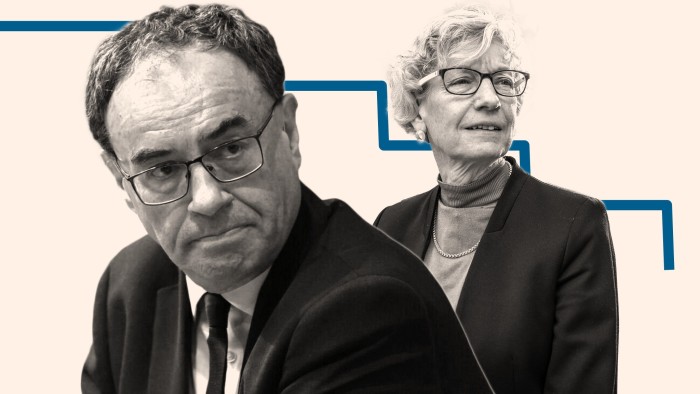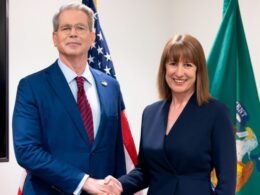Unlock the Editor’s Digest for free
Roula Khalaf, Editor of the FT, selects her favourite stories in this weekly newsletter.
A three-way split among Bank of England policymakers took investors by surprise on Thursday, denting expectations that the upheaval in global trade would lead the central bank to speed up the pace of interest rate cuts in the months to come.
But the BoE’s Monetary Policy Committee had a clear message for markets: despite the potential for tariffs to hit global growth, the BoE’s focus is on the domestic economy.
“That is ultimately what matters for UK inflation and monetary policy,” the BoE governor Andrew Bailey said following the decision to cut interest rates to 4.25 per cent.
Bailey said the overall impact of tariffs on inflation was still unclear, as they could both pull down global export prices and add to the costs of production through global supply chains. But at present, the biggest factor driving UK inflation was the strength of domestic wage growth.
“Interest rates are not on autopilot. They cannot be. Instead, the MPC must continue to respond carefully to evolving economic circumstances,” Bailey said.
Other committee members placed weight on different risks, however, leading to a split decision.
The two MPC members who favoured a bigger 0.5 percentage point rate cut, Swati Dhingra and Alan Taylor, believe that inflationary pressures in the UK economy are broadly contained, and that trade wars could hit global growth and export prices more than expected, pulling down UK inflation.
A UK-US trade deal, announced on Thursday, would only partly mitigate this, Bailey acknowledged, as the larger impact would flow from a slowdown in the UK’s other major trade partners, hinging on the US-China relationship.
But the BoE’s latest central forecast suggests tariffs will have only a modest effect on the UK economy, cutting the level of GDP by 0.3 per cent and inflation by 0.2 percentage points over its three-year forecast horizon, relative to its February forecast.
“This is not doom and gloom at all,” Bailey said of the downgrade to the growth forecast.
Although business confidence remains shaky, the MPC believes that weak investment on the part of companies will be offset by stronger consumer spending, and by a sharp rise in housing investment on the back of the government’s planning reforms.
The more hawkish MPC members worry that households have become more sensitive to short-term movements in prices since the cost of living crisis. This could mean that a temporary bump in inflation this year — as a result of the rise in regulated utility bills — becomes more persistent as workers push for higher wages to maintain their living standards.
Huw Pill, the BoE’s chief economist and an influential voice on the committee, swung to the more hawkish camp, joining Catherine Mann in voting to maintain rates at 4.5 per cent.
But even among the five members who voted to cut rates by a quarter of a point, a majority had seen the decision as “finely balanced” between no change and a rate reduction, and felt developments in global trade had tipped the balance.
“Underlying the plethora of views within the MPC is a plethora of risks,” said Sandra Horsfield, economist at Investec, adding that this left the outlook for rates “very fluid”.
Ruth Gregory, at consultancy Capital Economics, said it now looked unlikely that the BoE would accelerate its rate cuts, even if it was still on course to make two more quarter-point cuts by the end of the year.
“The market can rule out jumbo rate cuts,” Rob Wood, chief UK economist at Pantheon Macroeconomics, but he added the MPC had left the door open to moving faster “if erratic US policy hits demand further, or there are signs of serious cracks in the UK labour market”.
Source link









